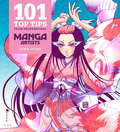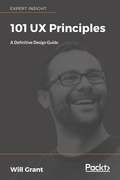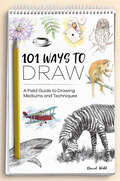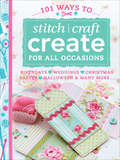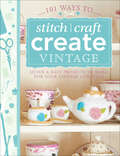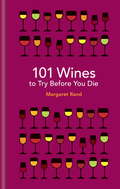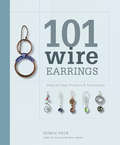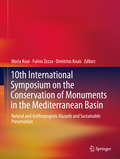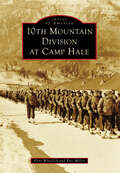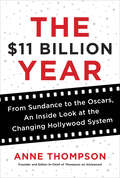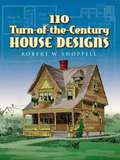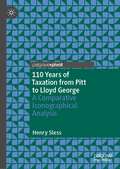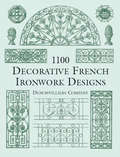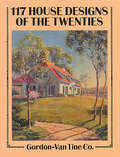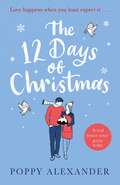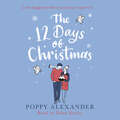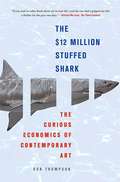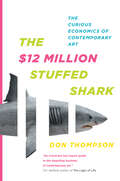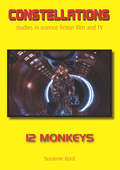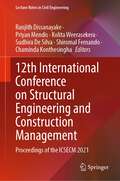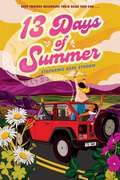- Table View
- List View
101 top tips From Professional Manga Artists
by Sonia LeongThe great popularity of Japanese comics and animated media has made manga art one of the hottest commodities in today's commercial art market. 101 Top Tips from Professional Manga Artists shows illustrators how to succeed in that market. Written by two successful manga artists, with additional insights from a select group of fellow professionals, this illustration-packed book covers all aspects of manga art, presenting advice and instruction on-- Research and inspiration for graphic and story ideas Tools and equipment Drawing characters, with attention to hairstyles, expressions, and poses Adding backgrounds, props, and elements from nature Creating illustrations in black and white, in color, painting in Photoshop, and using markers Creating comics with story, script, speech bubbles, and graphic sound effects Preparing finished work for the web and for print Here in a single volume is virtually everything an illustrator needs to know in order to create successful manga art for a variety of media. More than 400 color illustrations.
101 Top Tips from Professional Manga Artists
by Sonia Leong Meredith WalshAs a sophisticated and highly stylised art form, Manga presents a series of challenges for budding artists, from character and set design to creating dynamic page layouts, perfectly paced narrative and panels with ever-changing camera angles.Here, award-winning professional Manga artist Sonia Leong and a collective of acclaimed creators lay bare the expert techniques that you need, from essential drawing tips to designing characters, painting vivid illustrations and exciting storytelling.Manga comes in a variety of styles, from kawaii (cute) to hyper-realistic. 101 Top Tips from Professional Manga Artists identifies the key features of each, enabling you to develop your individual style.Including both traditional and digital art methods alongside tips on becoming a professional, 101 Top Tips from Professional Manga Artists is the ultimate resource for beginners and more experienced artists alike.
101 UX Principles: A Definitive Design Guide
by Will GrantLearn from the opinions of a UX expert, evaluate your own design principles, and avoid common mistakes.Key FeaturesHear insights from an author who was trained by the Nielsen Norman GroupBrowse over 20 years of collected UX insightsAccept or reject 101 thought-provoking opinions on designChallenge your own ideas on UXBook DescriptionThere are countless books about designing for the web. They all give multiple routes and options to solving design challenges. Many of them are plain wrong. This has led to an entire generation of designers failing to make interfaces that are usable, software that is intuitive, and products that normal people can understand. 101 UX Principles changes that, with 101 ways to solve 101 UX problems clearly and single-mindedly.The 101 principles are opinionated. They’ll rub some designers up the wrong way, but these principles are rooted in 20 years of building for the web. They’re not based on theory - they’re based on practice. Simply put, they’ve been proven to work at scale. There’s no arguing with that.Following in the footsteps of Jakob Nielsen and Don Norman, this book is the go-to manual for UX professionals, covering everything from passwords, to planning the user journey. Build a deeper understanding of accessible design and implement tried-and-tested strategies in your company. What you will learnUse typography well to ensure that text is readableDesign controls to streamline interactionCreate navigation which makes content make senseConvey information with consistent iconographyManage user input effectivelyRepresent progress to the userProvide interfaces that work for users with visual or motion impairmentsUnderstand and respond to user expectationsWho this book is forThis book is for UX professionals (freelance or in-house) looking for shortcuts to making software that users intuitively know how to use across web, desktop, and mobile.
101 UX Principles: Actionable Solutions for Product Design Success, 2nd Edition
by Will GrantImprove user experience by avoiding common frustrations and focusing on what mattersBook DescriptionDesign is everywhere. Take a look around you right now and consider the products and services we use every day. You'll notice that our computer and phone operating systems, our web browsers, and the apps we use to work, order food, socialize and even date have been designed by UX specialists to offer you the best experiences when using their products and services.Of course, not all online experiences are designed with our best interests in mind. That's exactly why UX design is such an exciting and rewarding field—by learning the logic behind what people engage with and implementing it in your UX work, you can craft intuitive, accessible, and highly functional designs for your digital products.The 2nd edition of 101 UX Principles is the perfect companion when working on digital projects and making the right decisions for your users. From landing pages and checkout basket UIs to startup launch products and enterprise software solutions, a rich user experience design will maximize the success of your product.The book includes an exclusive invitation to join an online UX designers' community, where you can read the book alongside peers and other UX designers, and participate in various challenges and discussions with the author. See you there!Endorsements"This updated version of 101 UX Principles is a delight. Thoroughly revised, this edition includes great points from the earlier edition, offers some updated examples, and provides new examples of solid UX principles. Theory goes into practice with examples that we can all relate to. The author says this book is a 'shortcut to success' for less experienced designers and a challenge to accepted thinking for seasoned UX professionals. It is that, yes, and it is so much more. It's an educational and fun provocation to look at the world of UX differently – solidly from the user's point of view."—Elizabeth Churchill, Director of User Experience, Google"They say UX is liquid - you can't pin it down. Well, they haven't read this book. In a series of short, direct lessons, this book lays out the fundamental principles of good user experience design. Complete with case studies, a record of personal experience, and visual examples, Grant makes it clear why these techniques have found their way into the canon of UX best practices. This is a phenomenal reference guide as you set out on your UX journey or even if you've been on it for many years."—Jeff Gothelf, Author of Lean UXSneak a peek at some of the new and updated principles in this UX design book:Work with user expectations, not against themMake interactive elements obvious and discoverableOptimize your interface for mobileStreamline creating and entering passwordsRespect users' time and effort in your FormsUse animation with care in user interfacesHow to handle destructive user actionsChatbots are usually a bad ideaUse A/B testing to test your ideasLet users give feedback, but don't hassle themMake it clear to users if they're joining or signing-inOnly use modal views for blocking actionsComplexity can be good for some usersWho this book is forThis book is a distillation of Will's 20+ years of experience in the form of successful design principles to help early career UX designers learn the ropes, and provide experienced professionals with new ideas when building their products.UX/UI designers, product managers, entrepreneurs, aspiring strategists, and anyone creating a digital product, service or a campaign will find this book extremely useful.
101 Ways to Draw: A Field Guide to Drawing Mediums and Techniques
by David WebbMaster and combine different media in your drawing—from soft pencils to graphite powder, ballpoint to fiber-tip pens, conté sticks to watercolor pencils.This visual directory of drawing techniques beyond the pencil provides you with the skills to explore and experiment with all the different techniques and mediums. Use it as a handy reference for when you want to know how to use a particular tool, or as a catalogue of inspiration when seeking new ideas to try.A wealth of media and equipment is demonstrated, and each page features invaluable information for beginners and accomplished artists alike. As the techniques progress, you’ll explore the creative possibilities beyond one medium, and be encouraged to look at your work and style in a new light.Start with basic graphite pencils, sticks and powder to explore line and tone, shading, creating textures and erasing. Then move on to coloured pencils to cover techniques such as burnishing, lifting and sgraffito. There are various interesting methods to try with water-soluble coloured pencils too, including different ways of applying water, blending and overlaying colours.There are some really interesting ways to use ink pens for painting effects and instructions are included for cutting your own quill pen. Ballpoint pens, fiber-tips, marker pens and brush pens are also great tools for creating modern, graphic drawings—pick up some handy tips for mark making and blending.Finally, experiment with mixed media and combining various pencils, pastels, crayons, powder, sticks and pens for some stunning results. Be inspired by the huge range of drawings in this book to expand and develop your own skills.
101 Ways to Stitch, Craft, Create for All Occasions: Birthdays, Weddings, Christmas, Easter, Halloween & Many More . . .
by Various ContributorsCelebrate throughout the calendar year with handmade crafts, from knitting and quilting to beading and cake decorating. Want to make gorgeous homemade gifts, cakes, cards, and decorations? This stunning collection of all-new projects includes something for every occasion with a wide range of crafts to enjoy, from stitching stuffed animals to baking cookie bouquets, creating macramé bracelets to constructing gift boxes. 101 Ways to Stitch, Craft, Create for All Occasions features: · Simple step-by-step projects · Quick makes for fast results · Helpful time and difficulty indicators
101 Ways to Stitch, Craft, Create Vintage: Quick & Easy Projects to Make for Your Vintage Lifestyle
by Various ContributorsBe inspired to get crafting with this fun collection of 101 unique vintage-themed projects. Create stunning crafts for yourself or as gifts for friends and family, with a huge selection of vintage projects to choose from, including a vintage button necklace, suffolk puff rings, fondant fancies, fabric pin cushion, crochet hot water bottle cover, and vintage tea stand. The beautiful projects cover food and drink, home and garden, fashion, and gifts giving you the opportunity to try something new and expand your crafting skills from sewing and knitting to papercraft and cake decorating! Every project is quick and simple to make with easy to follow step-by-step instructions and there is a helpful techniques section at the back of the book, so you'll be a crafting pro in no time. This stunning collection of craft projects will inspire you to stitch, craft and create your very own vintage lifestyle!
101 Wines to try before you die
by Margaret RandThe world is full of wines. So why waste your time drinking something mediocre? Award-winning author Margaret Rand has selected the 101 wines you should taste in your lifetime. Some will definitely challenge your bank balance - but are so worth it; some are classics that any serious wine lover should experience; others are secret inexpensive gems that you will be delighted to discover. Together they form a fabulous selection of must-drink wines.From the prestigious vineyards of France and California to lesser-known wine makers in Hungary and Greece, discover the best wines from across the globe. Complete with tasting notes, advice on the best vintages and dishes to pair with the wines, this is the perfect gift for both wine aficionados and wine novices alike.
101 Wire Earrings: Step-by-Step Projects & Techniques
by Denise PeckWire is the hottest trend in jewelry making.101 Wire Earrings gives wireworkers of all skill levels the information and inspiration to make innovative, stylish, and contemporary earrings.Following in the footsteps of Wire Style, author Denise Peck offers an inspiring selection of 101 stunning wire earrings from top designers. The clear instructions are enhanced by step-by-step photographs and the projects are broken into beginner, intermediate, and advanced categories.Included inside:Step by step instructions on how to make head pins and French ear wiresTechniques for hammering and texturing wire Tricks to coil, spiral, harden, and straighten wire Definitions of the important elements that make up earrings, including headpins, jump rings, hoops, loops, coils, spirals, ear wires.With projects that are inexpensive and require minimal tools, this book is a must have for any jewelry or wire artist wanting to build their skills or be inspired by new ideas, beautiful materials and creative designs.
10th International Symposium on the Conservation of Monuments in the Mediterranean Basin: Natural and Anthropogenic Hazards and Sustainable Preservation
by Maria Koui Fulvio Zezza Dimitrios KouisThis book addresses physical, chemical, and biological methods for the preservation of ancient artifacts. Advanced materials are required to preserve the Mediterranean belt's historic, artistic and archaeological relics against weathering, pollution, natural risks and anthropogenic hazards. Based upon the 10th International Symposium on the Conservation of Monuments in the Mediterranean Basin, this book provides a forum for international engineers, architects, archaeologists, conservators, geologists, art historians and scientists in the fields of physics, chemistry and biology to discuss principles, methods, and solutions for the preservation of global historical artifacts.
10th Mountain Division at Camp Hale (Images of America)
by Flint Whitlock Eric MillerIn 1942, at the beginning of World War II, the US Army built its most unusual military post for its most unusual division in a high, remote, Rocky Mountain valley 100 miles west of Denver, Colorado. Located at 9,250 feet above sea level, Camp Hale was the training home of the famed 13,459-man 10th Mountain Division, which trained in mountain warfare techniques for two years--and almost missed the war. After they were finally deployed for combat in early 1945 in the Northern Apennine Mountains of Italy, the young men of the 10th never lost a battle or gave up a foot of ground. And, after the war, many of the veterans returned home to create America's ski and winter sports industry. Building Camp Hale was an incredible feat of wartime engineering and construction. To transform the wild, alpine meadow into an Army camp, 10,000 civilian construction workers were hired to scrape away the vegetation; level the valley floor; install roads and water and sewer lines; build 1,000 structures and two ski areas; and relocate a highway and railroad line--all within seven months and at a cost of $31 million (over a half billion dollars in today's money). Yet Camp Hale was demolished two years after it was built.
The $11 Billion Year: From Sundance to the Oscars, an Inside Look at the Changing Hollywood System
by Anne Thompson"This chronicle of 2012 is a slice of what happened during a watershed year for the Hollywood movie industry. It's not the whole story, but it's a mosaic of what went on, and why, and of where things are heading."What changed in one Hollywood year to produce a record-breaking box office after two years of decline? How can the Sundance Festival influence a film's fate, as it did for Beasts of the Southern Wild and Searching for Sugar Man, which both went all the way to the Oscars? Why did John Carter misfire and The Hunger Games succeed? How did maneuvers at festivals such as South by Southwest (SXSW), Cannes, Telluride, Toronto, and New York and at conventions such as CinemaCon and Comic-Con benefit Amour, Django Unchained, Moonrise Kingdom, Silver Linings Playbook, Les Misérables, The Life of Pi, The Avengers, Lincoln, and Argo? What jeopardized Zero Dark Thirty's launch? What role does gender bias still play in the industry? What are the ten things that changed the 2012 Oscar race?When it comes to film, Anne Thompson, a seasoned reporter and critic, addresses these questions and more on her respected daily blog, Thompson on Hollywood. Each year, she observes the Hollywood machine at work: the indies at Sundance, the exhibitors' jockeying at CinemaCon, the international scene at Cannes, the summer tentpoles, the fall's "smart" films and festivals, the family-friendly and big films of the holiday season, and the glamour of the Oscars®. Inspired by William Goldman's classic book The Season, which examined the overall Broadway scene through a production-by-production analysis of one theatrical season, Thompson had long wanted to apply a similar lens to the movie business. When she chose 2012 as "the year" to track, she knew that box-office and DVD sales were declining, production costs were soaring, and the digital revolution was making big waves, but she had no idea that events would converge to bring radical structural movement, record-setting box-office revenues, and what she calls "sublime moviemaking."Though impossible to mention all 670-plus films released in 2012, Thompson includes many in this book, while focusing on the nine Best Picture nominees and the personalities and powers behind them. Reflecting on the year, Thompson concludes, "The best movies get made because filmmakers, financiers, champions, and a great many gifted creative people stubbornly ignore the obstacles. The question going forward is how adaptive these people are, and how flexible is the industry itself?"
110 Turn-of-the-Century House Designs
by R. W. ShoppellWith its wealth of representative styles and its emphasis on craftsmanship and exterior design, the late-Victorian era ranks among the halcyon days in American house building. This survey of the era's traditional designs--reproduced from a rare edition--offers a complete and authentic guide to faithful restorations or re-creations.A New York City-based firm prepared and published this catalog in 1897, selecting the very best models from more than 12,000 houses built from their plans. Designed with style, utility, and low cost of construction uppermost in mind, it features hundreds of illustrations, including perspective drawings and floor plans. Details of interior and exterior materials and potential modifications include remarks on the particular amenities of each house, plus estimates of building costs. Antique collectors, home hobbyists, and fans of traditional design will find this volume a valuable reference and an endless source of inspiration.
110 Years of Taxation from Pitt to Lloyd George: A Comparative Iconographical Analysis
by Henry SlessThis book offers a multi-disciplinary visual analysis of British taxation history during the long nineteenth century. Focusing specifically on cartoons from the period, the book utilises the author’s innovative PEARL methodology to analyse the impact of Publishers’ attitudes, Editorial techniques, Artistic methods, Readers’ responses, and Legal context on historical images published in this period.The book outlines a financial and visual context for the long nineteenth century, discussing the importance of political images during a period when the relationship between the state and the taxpayer was fundamentally shifting. The state of public finance in Britain as a whole, including the growth of institutional finance, the economic impact of wars, and attempts to reduce the national debt, are considered alongside an exploration of the recurring iconographical styles of the period. The book situates the visual history of taxation within a wider context of politicised images responding to fiscal events, and uses the PEARL analysis technique to pinpoint nuanced and evolving public attitudes towards tax structures in Britain, as well as comparative developments in the US such as the impact of the Civil War and income tax debates. The book will be of interest to financial historians and academic cultural historians, as well as all those interested in visual culture and political imagery.
1100 Decorative French Ironwork Designs (Dover Pictorial Archive)
by Denonvilliers Co.Invaluable source of information for art historians, craftspeople, dealers, collectors, and preservationists includes hundreds of finely detailed illustrations of garden seats, candelabras, moldings, gates, balcony grilles, vases, crosses, funerary ornaments and monuments, finials, doorknobs and many other ornamental features. A rich source of inspiration and royalty-free graphics, as well, for commercial artists and designers.
117 House Designs of the Twenties (Dover Architecture)
by Gordon-Van Tine Co.In the post-World War I era, as the economic boom of the 1920s gathered momentum, millions of Americans set out to make the dream of owning their own home come true. Labor and materials were plentiful and cheap, and new trends in home design made the prospect of homebuilding an exciting venture. This fascinating book, a reprint of a rare catalog of prefabricated houses from 1923, reveals in detail the types of design offered to those in the market for a new home in the early 1920s.Of the 117 designs included, most are substantial middle-class homes. But the popularity of cottages and bungalows is also apparent in the wide selection of practical and appealing designs depicted. And there are large, formal homes as well, many of which embody America's unflagging interest in colonial styling. Some have affluent touches such as a sleeping porch or a sun room. Many reflect a strong interest in exterior detailing, in the form of cypress siding, broad eaves, heavy timber brackets, stucco pillars, and flower boxes, among other features.Each house is shown in a large frontal illustration. Floor plans for the first and second floors are included, and interior and exterior detailing are extensively described. The specifics of plumbing, heating, and lighting are included in a special section at the back of the book.Architects, architectural and social historians -- anyone interested in American home design -- will enjoy the rich variety of designs presented. Republished in association with the Athenaeum of Philadelphia, this authentic catalog provides not only an indispensable repository of information about the homes themselves but a source of insight into American life at a time when owning a home became a widely realizable dream for a rapidly growing middle class.
The 12 Days of Christmas
by Poppy Alexander'A real festive treat' JULES WAKE'Heart-melting and mouthwatering, this Christmas treat is as sweet and delicious as a marron glacé' VERONICA HENRY'Deliciously romantic' WOMAN'S OWN'All the joy of Christmas in one delicious, utterly mouth-watering package' JULIE CAPLIN'Romantic and uplifting' WOMAN & HOMEThe most magical time of the year...For the first time in ten years, Freya is back in the little village of Middlemass for Christmas. The streets might be twinkling with fairy lights, but after the recent loss of her mother, she's never felt less festive. Forced to sleep under the same roof as her handsome neighbour Finn, Freya realises she's going to need a distraction - fast! So she sets herself a challenge: to cook the '12 Days of Christmas'. Her delicious food soon brings the villagers together, and as each day passes, old friendships are renewed, memories stirred and there's even the flickering of romance... She was only meant to stay for the holidays, but could Middlemass - and Finn - steal her heart forever?***Praise for Poppy Alexander:'Friendship, community and a little bit of romance - what's not to love?' Mandy Baggot'Books, bats and romance...a perfect escape. I loved spending time with the characters of Middlemas.' Liz Fenwick'My first Poppy Alexander book but definitely not my last. What a lovely, engaging, perceptive story The Littlest Library is' Sue Moorcroft'Five of the biggest stars for The Littlest Library. I thoroughly enjoyed spending some time with Jess and her phone box full of books.' Catherine Miller'I loved everything about this book. It is filled with so much warmth, gentle humour and some very heart touching moments' Sue Fortin'A great festive read.' NetGalley Reviewer'This book was literally one of my favourite reads this year!' NetGalley Reviewer
The 12 Days of Christmas
by Poppy Alexander'A real festive treat' JULES WAKE'Heart-melting and mouthwatering, this Christmas treat is as sweet and delicious as a marron glacé' VERONICA HENRY'A festive romance that reminds us of the importance of living in the moment' HELEN ROLFE'Deliciously romantic' WOMAN'S OWN'All the joy of Christmas in one delicious, utterly mouth-watering package' JULIE CAPLIN'Romantic and uplifting' WOMAN & HOME'Charming, full of festive fun and romance' MY WEEKLYThe most magical time of the year...For the first time in ten years, Freya is back in the little village of Middlemass for Christmas. The streets might be twinkling with fairy lights, but after the recent loss of her mother, she's never felt less festive. Forced to sleep under the same roof as her handsome neighbour Finn, Freya realises she's going to need a distraction - fast! So she sets herself a challenge: to cook the '12 Days of Christmas'. Her delicious food soon brings the villagers together, and as each day passes, old friendships are renewed, memories stirred and there's even the flickering of romance... She was only meant to stay for the holidays, but could Middlemass - and Finn - steal her heart forever?***Praise for Poppy Alexander:'Friendship, community and a little bit of romance - what's not to love?' Mandy Baggot'Books, bats and romance...a perfect escape. I loved spending time with the characters of Middlemas.' Liz Fenwick'My first Poppy Alexander book but definitely not my last. What a lovely, engaging, perceptive story The Littlest Library is' Sue Moorcroft'Five of the biggest stars for The Littlest Library. I thoroughly enjoyed spending some time with Jess and her phone box full of books.' Catherine Miller'I loved everything about this book. It is filled with so much warmth, gentle humour and some very heart touching moments' Sue Fortin'A great festive read.' NetGalley Reviewer'This book was literally one of my favourite reads this year!' NetGalley Reviewer
The 12 Days of Christmas: A heartwarming and uplifting romance to curl up with over the festive holidays
by Poppy Alexander'A real festive treat' JULES WAKE'Heart-melting and mouthwatering, this Christmas treat is as sweet and delicious as a marron glacé' VERONICA HENRY'A festive romance that reminds us of the importance of living in the moment' HELEN ROLFE'Deliciously romantic' WOMAN'S OWN'Such a warm, delightful Christmas tale' CATHERINE MILLER'All the joy of Christmas in one delicious, utterly mouth-watering package' JULIE CAPLIN'Romantic and uplifting' WOMAN & HOME'Charming, full of festive fun and romance' MY WEEKLY'Utterly brilliant' CLAIRE WADEThe most magical time of the year...For the first time in ten years, Freya is back in the little village of Middlemass for Christmas. The streets might be twinkling with fairy lights, but after the recent loss of her mother, she's never felt less festive. Forced to sleep under the same roof as her handsome neighbour Finn, Freya realises she's going to need a distraction - fast! So she sets herself a challenge: to cook the '12 Days of Christmas'. Her delicious food soon brings the villagers together, and as each day passes, old friendships are renewed, memories stirred and there's even the flickering of romance... She was only meant to stay for the holidays, but could Middlemass - and Finn - steal her heart forever?***Praise for Poppy Alexander:'Friendship, community and a little bit of romance - what's not to love?' Mandy Baggot'Books, bats and romance...a perfect escape. I loved spending time with the characters of Middlemas.' Liz Fenwick'My first Poppy Alexander book but definitely not my last. What a lovely, engaging, perceptive story The Littlest Library is' Sue Moorcroft'Five of the biggest stars for The Littlest Library. I thoroughly enjoyed spending some time with Jess and her phone box full of books.' Catherine Miller'I loved everything about this book. It is filled with so much warmth, gentle humour and some very heart touching moments' Sue Fortin'A great festive read.' NetGalley Reviewer'This book was literally one of my favourite reads this year!' NetGalley Reviewer
The $12 Million Stuffed Shark: The Curious Economics of Contemporary Art
by Don ThompsonWhy would a smart New York investment banker pay $12 million for the decaying, stuffed carcass of a shark? By what alchemy does Jackson Pollock's drip painting No. 5, 1948 sell for $140 million? Intriguing and entertaining, The $12 Million Stuffed Shark is a Freakonomics approach to the economics and psychology of the contemporary art world. Why were record prices achieved at auction for works by 131 contemporary artists in 2006 alone, with astonishing new heights reached in 2007? Don Thompson explores the money, lust, and self-aggrandizement of the art world in an attempt to determine what makes a particular work valuable while others are ignored. This book is the first to look at the economics and the marketing strategies that enable the modern art market to generate such astronomical prices. Drawing on interviews with both past and present executives of auction houses and art dealerships, artists, and the buyers who move the market, Thompson launches the reader on a journey of discovery through the peculiar world of modern art. Surprising, passionate, gossipy, revelatory, The $12 Million Stuffed Shark reveals a great deal that even experienced auction purchasers do not know.
The $12 Million Stuffed Shark: The Curious Economics of Contemporary Art
by Don ThompsonThe $12 Million Stuffed Shark delves into the economics and psychology of the contemporary art world – artists, dealers, auction houses, and wealthy collectors. If it’s true – as so often said – that 85 percent of new contemporary art is bad, why were record prices achieved at auction for works by 131 contemporary artists in 2006 alone, with astonishing new heights reached in 2007? The $12 Million Stuffed Shark explores money, lust, and the self-aggrandizement of possession in an attempt to determine what makes a particular work of art valuable while others are ignored. In the style of the bestselling Freakonomics, Thompson uses economic concepts to explain the unique practices employed, to great success, in the international contemporary art market. He discusses branding and marketing and how various strategies are tailored to a wealthy clientele, driving a "must-have" culture. Drawing on exclusive interviews with both past and present executives of auction houses and art dealerships, artists, and the buyers who move the market, Thompson launches the reader on a surprising journey of discovery.
12 Monkeys (Constellations)
by Susanne KordTerry Gilliam’s 12 Monkeys (1995) was a commercial and critical success, but it is Gilliam’s least understood film, even on the basic plot level. Aside from recognizable debts to specific films such as La Jetée (1962) and Dr. Strangelove (1964), 12 Monkeys plays with a number of genres: apocalypse and postapocalypse movies, sci-fi, nuclear noir, and what is becoming known as “geek dystopia.” This volume in the Constellations series examines Gilliam’s film—and briefly the TV series based on it—in the context of post-apocalypse movies and with an eye to the film’s major themes, including mental illness, conspiracy theories, the impossibility of human closeness, and the nature of reality. It is the first to read 12 Monkeys’s portrayal of time travel in light of Einstein’s ideas about time and to ask what answers these ideas suggest to the film’s most basic philosophical predicament: the problem of free will versus determinism.
124 Distinctive House Designs and Floor Plans, 1929
by National Building PublicationsAn annual publication intended as a reference work for contractors, suppliers, architects, and homeowners, the 1929 Home Builders Catalog offered a beautifully illustrated look at a variety of homes. Painstakingly reproduced from a rare edition, this volume offers old-house restorers, preservationists, and lovers of 1920s architecture an authentic view of American homes of the era.
12th International Conference on Structural Engineering and Construction Management: Proceedings of the ICSECM 2021 (Lecture Notes in Civil Engineering #266)
by Ranjith Dissanayake Priyan Mendis Kolita Weerasekera Sudhira De Silva Shiromal Fernando Chaminda KonthesinghaThis book highlights advances in the fields of civil engineering and construction industry with a particular focus on Structural Engineering and Construction Management. This book consists of top quality and innovative research papers selected from the proceedings of the 12th ICSECM 2021 under the themes of Innovations in Building Materials, Construction Management, Tall buildings, Concrete Technology and High Performance concrete, Geotechnical Engineering, Water and Waste Water Treatment, CKDu problem in Sri Lanka, Structural Health Monitoring & Design of Resistive Structures, Disaster Risk Reduction and Resilience in the Built Environment, Fibre Reinforced Polymer, Life Cycle Assessment of Buildings and Fire Safety Engineering.
13 Days of Summer
by Stephanie Kate StrohmThis unforgettable and fun novel follows three best friends and one hot hitchhiker entering their summer road trip era, it's all about that reputation. . . It&’s the summer after senior year of high school for Carson, Noemi, and Eleanor, and they intend to live it up while they can. What could be more epic than a cross-country road trip to see Taylor Swift in concert? Along the way, the friends pick up a mysterious and charming guy who is stranded at a rest stop (is that a James Dean daydream look in his eyes?). As she and Carson hit it off, Carson gets a crash course in love-at-first sight. But as attractions grow, so, too, do tensions among the friends. Will the group make it to the concert with relationships intact? Or is there too much bad blood? At its core, a novel about the power and possibility of friendships, sprinkled with just enough romance and set against the ultimate summer playlist, this lighthearted read is both a quintessential teen romance and coming-of-age novel that will stay with readers long after Taylor sings her last note.
